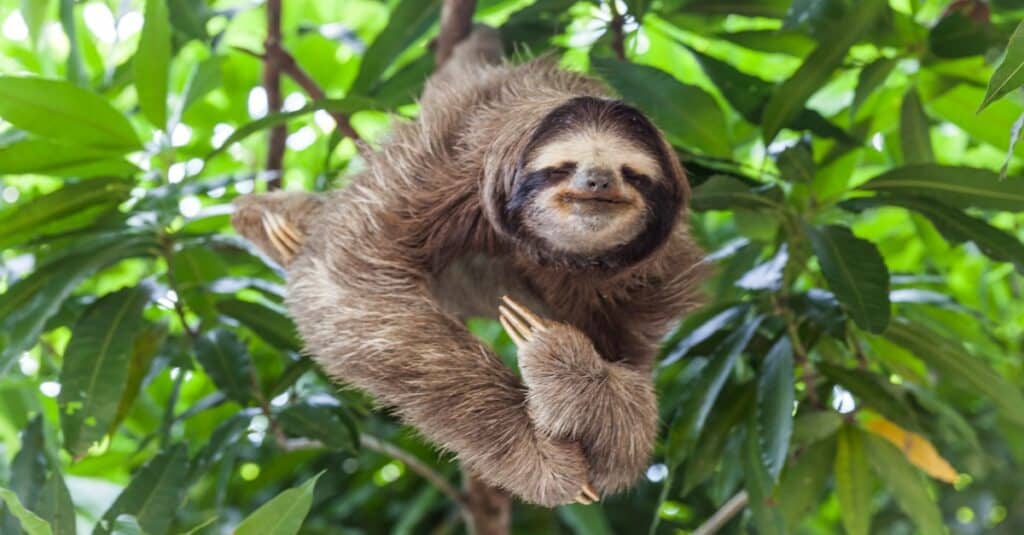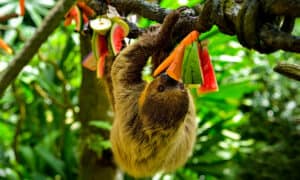There is something pretty amazing about sloths, who are known for their lazy, carefree attitude towards life. However, for those that don’t know, a sloth is a slow-moving tropical mammal that hangs upside-down from trees in tropical rainforests throughout Central America and South America. They’re also known for being quite cute, so it’s no wonder that they’re such a popular and well-known animal! However, did you know that many sloth populations are on the endangered species list? Let’s look at how many sloths are left in the world and what conservation efforts are being made to help them.
How Many Sloths Are Left In The World?

The IUCN Red List of endangered animals lists two species of sloths.
©iStock.com/Parkol
There has been a steady decline in the number of these unhurried mammals as the years pass. Approximately 1,500 sloths stand in the wild today, according to the World Wildlife Fund (WWF). Currently, the pygmy three-toed sloth is categorized as “Critically Endangered” and the maned three-toed sloth is classified as “Vulnerable.” In 2013, the IUCN estimated that there were less than 100 pygmy sloths left in the world, and they live only on Escudo de Veraguas Island in Panama.
Maned sloths, which are mainly native to Brazil, are also slowly declining in population. Although they are considered “Least Concern,” the remaining four species still face threats and population declines. Taking a closer look at the sloth population by species, let’s take a closer look at the population trends.
Sloth Population By Species

Sloths come in two varieties, two-toed and three-toed, and there are six species in total.
©iStock.com/Nachosuch
There are two types of sloths, the two-toed and three-toed sloths, and six species of sloth in total. It is important to note that each of these species has its own unique habitat, attributes, and endangered status. Here are some stats at a glance that show the diversity and particular situations of each sloth species.
Pygmy Three-Toed Sloth
In 2001, this species was recognized as a distinct species, making it the smallest of the sloths. Pygmy three-toed sloths live primarily in mangrove trees on the Panamanian island Isla Escudo de Veraguas. Their population is currently less than 100, which makes them critically endangered. There is a continuing decline in the population of this species.
Maned Three-Toed Sloth
Maned three-toed sloths are the largest of the sloth species and spend much of their lives hanging upside down in trees. The fur on its body grows in the opposite direction of most mammals due to its upside-down lifestyle. Currently, it is classified as a vulnerable species. It is not known exactly how many of these sloth species live in the wild, but their population is estimated between 100 and 200. Sadly, they are also experiencing a decline in population numbers.
Brown-Throated Three-Toed Sloth
Although it is called a “Brown-throated Sloth,” its fur may appear green or blue due to algae growth. The population of this sloth is generally stable and is distributed across many countries. The precise population numbers of these sloths are unknown, as they are with many other species of sloth.
Pale-Throated Three-Toed Sloth
Pale-throated sloths, like other sloths, can sometimes have a greenish tint to their fur when spotted. This is due to the algae growing on their fur! Sometimes, this can assist in camouflaging against predators. Pale-throated sloths also have the slowest digestion rates because leaves must ferment first in their guts. Currently, there are no known threats to this sloth due to the fact that it lives in one of the most untouched environments on earth.
Hoffman’s Two-Toed Sloth
Among the sloth species, Hoffman’s two-toed sloth is the only one that has two, discontinuous populations separated by the Andes mountain range. In contrast to the Pygmy three-toed sloth or the Maned three-toed sloth, their habitat has not been reduced to the same extent. This is why they are currently classified as Least concern.
Linnaeus’s Two-Toed Sloth
The Linnaeus two-toed sloth is largely nocturnal and solitary. The species is known for its long fur, the habit of staying motionless for long periods of time, and webbed toes on its front paws. It is of the least concern and is not known to be a threat primarily due to its habitat.
Factors Contributing To The Decline Of Sloth Populations
So what is causing this significant decline in the sloth species? There are several factors that have been contributing to this decline. They include deforestation, poaching, illegal trafficking, and more. Let’s take a look at these in more detail.
Habitat Loss
Sloth habitat is being lost due to deforestation and human population growth. Because sloths live primarily in rainforests, preserving their environment is essential to their survival. Their diet and shelter are largely dependent on trees. In contrast, deforestation has resulted in large swaths of rainforest being cleared for crops and pastures. Due to their habit of rarely coming down from their tree canopies, sloths have no real protection from the elements if there are no forests.
The loss of habitat has also led to sloths coming closer and closer to humans. As a result, sloths also die when they collide with vehicles or climb on electrical wires.
Poaching
In the wild, sloths can live for 20 years if they’re safe from hunters. Sloths are species that are often hunted illegally, mainly because of their use in the pet trade. Since sloths are one of the slowest animals on earth, it is hard for them to escape quickly when humans encroach on their territory. Due to their low metabolic rate, sloths are sluggish, and they travel less than 40 yards a day. The meat of sloths is not widely popular, but they are sometimes hunted by poachers for trade and sale as pets.
What Is Being Done To Help Conserve The Sloth Population

Many conservation efforts are being made to help preserve the endangered sloth species.
©SergioDelgado / CC BY 2.0, Flickr – License
There are lots of conservation efforts being done to help with the sloth population. The Sloth Conservation Foundation and the Sloth Institute have developed a range of projects focusing on everything from public education and reforestation to the construction of road bridges and the insulation of power cables. In addition, making more eco-friendly choices in your everyday life can help lower your carbon footprint.
A major cause of rainforest destruction in Central and South America is palm oil. By purchasing palm oil products certified by the Rainforest Alliance, you ensure that no deforestation has taken place in the process of producing them.
The photo featured at the top of this post is © jdross75/Shutterstock.com
Thank you for reading! Have some feedback for us? Contact the AZ Animals editorial team.






